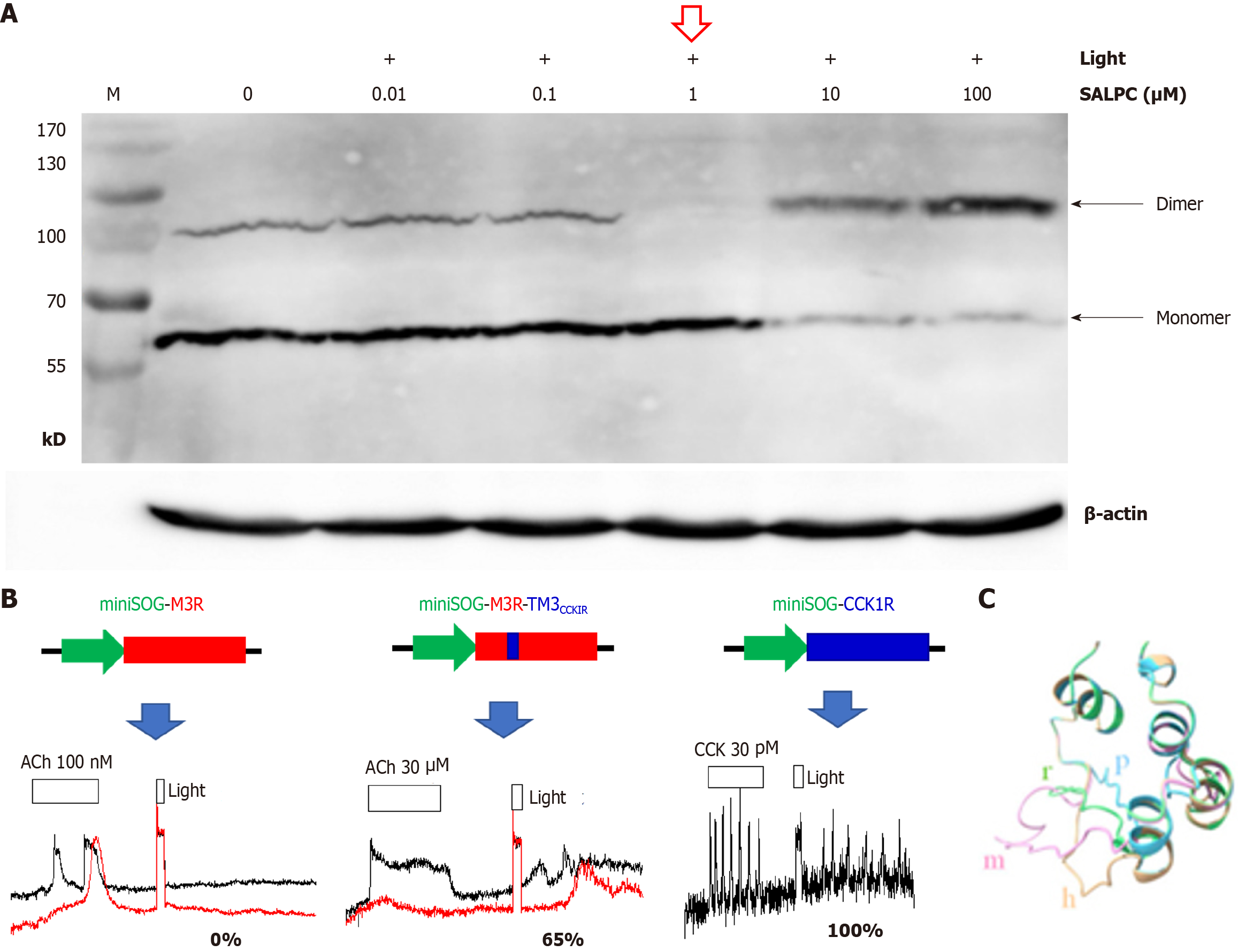Copyright
©The Author(s) 2025.
World J Gastroenterol. Mar 28, 2025; 31(12): 102423
Published online Mar 28, 2025. doi: 10.3748/wjg.v31.i12.102423
Published online Mar 28, 2025. doi: 10.3748/wjg.v31.i12.102423
Figure 3 Molecular mechanisms for permanent photodynamic activation of cholecystokinin 1 receptor.
A: Near quantitative photodynamic conversion [at sulphonated aluminum phthalocyanine (SALPC) 1 μmol/L + light, an intensity that would activate cholecystokinin 1 receptor (CCK1R) in live cells, note the red arrow] of CCK1R from dimer to monomer. Membrane proteins isolated from rat pancreatic acini were subject to photodynamic action (SALPC 0.01 to 100 μmol/L, light λ > 580 nm, 36.7 mW/cm2) before Western blot analysis. Note that higher photodynamic doses (SALPC 10 μmol/L, 100 μmol/L + light), not used in live cell experiments, led to cross-linking of CCK1R monomer. Modified from Jiang et al[41]; B: Transplantation of transmembrane domain 3 (TM3) from CCK1R to type 3 muscarinic acetylcholine receptor (M3R) generates chimeric receptor mini singlet oxygen generator (miniSOG)-M3R-TM3CCK1R, rendering non-susceptible M3R photodynamically activated. Calcium tracings are marked underneath with averaged percentage receptor activation (miniSOG-M3R 0%, miniSOG-tagged chimeric receptor 65%) compared with miniSOG-CCK1R (100%). Note that miniSOG (green arrow) is tagged to the N-terminus of M3R (red bar), CCK1R (blue bar), or the chimera M3R-TM3CCK1R (TM3CCK1R portion shown as blue and M3R portion shown as red). For clarity, only 2 cells are shown in the left and middle panel, and 1 cell is shown in the right panel. Reproduced from Li and Cui[43]; C: The length of secondary structure-free region in intracellular loop 3 (ICL3) correlates with sensitivity to photodynamic CCK1R activation: Mouse > rat > Peking duck. The complete ICL3 is shown. Note the complete alignment at beginning (top left) and end of ICL3. Alphabets are color coded on structure (m: mouse; h: human; r: rat; p: Peking duck). Reproduced from Wang and Cui[32]. SALPC: Sulphonated aluminum phthalocyanine; CCK1R: Cholecystokinin 1 receptor; M3R: Type 3 muscarinic acetylcholine receptor; miniSOG: Mini singlet oxygen generator; TM3: Transmembrane domain 3. Citation for Figure 3A: Jiang WY, Li Y, Li ZY, Cui ZJ. Permanent Photodynamic Cholecystokinin 1 Receptor Activation: Dimer-to-Monomer Conversion. Cell Mol Neurobiol 2018; 38: 1283-1292. Copyright© Springer Science Business Media 2018. Published by Springer Nature; Citation for Figure 3B: Li Y, Cui ZJ. Transmembrane Domain 3 Is a Transplantable Pharmacophore in the Photodynamic Activation of Cholecystokinin 1 Receptor. ACS Pharmacol Transl Sci 2022; 5: 539-547. Copyright© American Chemical Society 2022. Published by American Chemical Society; Citation for Figure 3C: Wang J, Cui ZJ. Photodynamic Activation of Cholecystokinin 1 Receptor Is Conserved in Mammalian and Avian Pancreatic Acini. Biomedicines 2023; 11: 885. Copyright© The Authors 2023. Published by MDPI. The authors have obtained the permission for figure using (Supplementary material).
- Citation: Cui ZJ. To activate a G protein-coupled receptor permanently with cell surface photodynamic action in the gastrointestinal tract. World J Gastroenterol 2025; 31(12): 102423
- URL: https://www.wjgnet.com/1007-9327/full/v31/i12/102423.htm
- DOI: https://dx.doi.org/10.3748/wjg.v31.i12.102423









